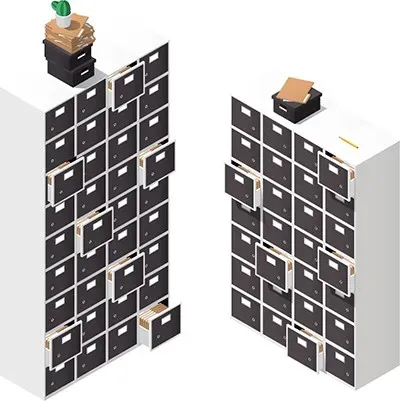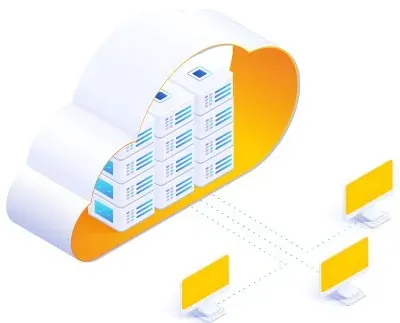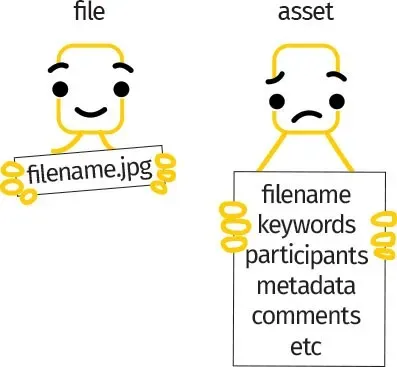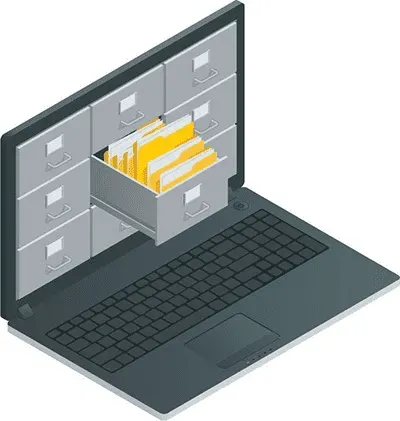In this article, you’ll learn:
If you are one of 180 000+ people asking Google “how to organize your files”, you definitely got acquainted with some smart pieces of advice like delete unused copies, sort your folders on the computer and get rid of duplicate files. Yeah… this all sounds reasonable enough. But when your digital library reaches 1000+ assets this beautiful logic begins to crumble.
Google recipes fail with big collections of files. Once again, you find yourself looking for a needle in a haystack. The problem becomes even worse if this needle costs you a million-dollar loss. The new era of digital mess is right at our door, but we still try to live in it with outdated instruments. How to survive and get your files organized in this chaos?
Let’s Go Back to History

The history of document management might have started with caves drawing, but our first chapter begins with Edwin Siebels who invented the filing cabinet in the 1880s to solve problems in a world with files disorder. A century later document management experienced a dramatic downturn with the development of computer technology. The development of servers allowed organizations to store documents electronically in centralized mainframes. This was the beginning of electronic document management systems (EDMS).
Later the rise of PCs gave businesses the ability to create and store documents on computers in the office. With thousands of documents scattered digitally, the issue of locating documents became increasingly important, which sparked game-changing innovation. Document management systems providers began to integrate full-text searching on personal computers in the same way a user searches Google for information or media.
These solutions worked well for quite a while. Until recently…
Return to Modern World

So, when the alarm bell started to ring? In fact, when new files formats developed. The simplest document management really worked in the twentieth century, but it was just a way to navigate inside one computer with very few files most of which were text and binary. As you understand there were no presentations, PDFs, videos, photos, fonts, Photoshop files, etc. In addition, we have not shared our files worldwide. The great cloud revolution made our files mess not only diverse but also global.
Unfortunately, we are still trying to cope with this variety of assets using the same tools as 50 years ago. As you can see in Google search results, we still believe that the placement of files in folders on a computer will solve our problem. This is like trying to kill a bear with a stick and paper. Of course, there is a good saying: “what doesn’t kill you makes you stronger”, but in our case “except for bears, bears will kill you”.
Welcome New Challenges at Your Door…
What is the real pain in the neck facing us these days? In the previous century, it was quite enough to have folders and files with some meaningful names not to get lost in them. Besides, the vast majority of files were binaries that you never needed to view. The files in 2019 are quite different from what they were in the 1980s.

Nowadays, you have a bigger fish to fry, as file became an asset with various properties apart from its name:
- Keywords and technical metadata, that describe its content
- Participants who create, edit and discuss this asset
- Connected assets that form a sequence of related files
- Special marks that help to differentiate between the files (colors, flags, etc.)
- History of files changes, which to understand how it developed
- File comments that show the discussion around the file and its changes
- Thumbnail that allows to visually differentiate between files
- Projects that involve his asset
Each of these properties can help to find and manage assets in a proper way, but in order to cope with these tasks, new approaches to document management are required. Are all of these properties important for your product or there is more trouble than it is worth to use them?
Check out this example…
Imagine you are a photographer and your file contains many technical details that are very meaningful and useful to you, including information about the camera and its settings, such as aperture, speed, ISO, lens, GPS location, etc. Suppose that you noticed one of the lenses used during the previous photosets was defective. With the help of metadata search, you could easily find all the photos made with this lens in a few clicks. Besides, metadata may contain copyright information, which is very important if you want to protect your work from illicit use.
So, when you have access to all this useful information embedded in your digital file, you are not dealing with a file any more. You’re dealing with an Asset. And this is the point where new approach to file management has to come in place. Nowadays you have to see all the relevant metadata and to search for your assets by their various features. You might require to modify the metadata like in our example, and these changes are to be preserved within your asset and stay available for your team.
But actually, this isn’t but the very tip of the iceberg…
File formats are being constantly upgraded, and new ones appear regularly. There is no single standard of creating and processing metadata that would be obligatory for everybody. As a result, there are a lot of overlapping fields that sometimes describe one and the same thing with different words. And there’s no feasible way to bring this all under control. Which standard to prefer? How to make sure that the information is saved in the correct field? What if we miss something important?
Whether you have a big corporation or a 3–5 members team working with 1000 assets, you will not avoid this digital files mess. The question is how to get your files organized effectively and overcome the chaos?
Learn the Secret of the Big Guys

Believe it or not, but big international corporations have known the answer for decades. They had a team of people and a heap of assets when they noticed the performance downgrade because of evolving complexity of the processes. In some time they crafted a solution, which worked as a file storage and database for metadata. Such software is currently called — DAM (digital asset management) solution. It streamlined their business process outperforming the competition miles ahead. In a new era of digital files mess, digital asset management is a crucial component of a marketing strategy for any business. Companies that invest in DAM solutions empower their teams to collaborate and build stronger brands.
Fly in the Ointment
Do you think it is easy to integrate the typical DAM software into your business processes?
Despair will be right at your door when you understand that half a year and thousands of dollars will be required to implement such a solution. You and your team will spend hours on the discussion of the features you require, on the customization of the system for your internal processes and on learning how to use it.
You feel a relief — the system is finally ready, but suddenly you found an aspect of your workflow missed during the implementation. In this case there are pretty high chances that you will have to pay for additional customization and trainings or even start from the very beginning. The most dramatic thing here — you start paying for the system from the date of the contract signature and continue paying for the subscription throughout the implementation cycle. In addition, the growth of your files storage will bring new expenses.
You can see now, a typical DAM solution costs tens of thousands to hundreds of thousands of dollars per year and requires substantial investment in licenses as well as months for implementation. Big global companies can afford that, but what to do if your budget is limited?
Climb Outside the Box and Find Your DAM
If you are organizing, storing, accessing, and distributing digital assets, you are engaging in digital asset management, and you’re probably using some system to accomplish that activity, although it may only be folders on a desktop. It is a good idea to think of digital asset management as a solution. It’s a system that allows your process to function. There are certain things that a solution must address if it is to be digital asset management and some things it should address to have a chance at being effective.
To make it simple, look at DAM as an equation:

Addressing the equation components you construct the DAM system that has:
Files storage that keeps all your needles in one place and you can easily find the one you need.
Metadata storage that keeps a description of what each of your assets is about, when and how it was made, how it is connected to other data in your storage. You can find any asset or group of assets with similar characteristics
Tools that allow to manage your assets, search through the library, organize them in collections, tag them with keywords, work with metadata, organize your team work, maintain version control, share your assets with other world and integrate your DAM with other services your require
The last but not the least, you want a DAM system that does not require any special installation process and its implementation process is intuitive enough. At the same time it has 24/7 support solving any of your questions during its usage.
Then, let’s return to expensive DAM solutions we discussed earlier. To make it simple, let’s call them classic DAM. Do they have all the parts of the equation? Definitely yes, but in case you purchase classic DAM solution the vendor will sell you all the parts of the equation multiplied by his interest.
What if you look at this equation from the other side and do not like to pay for the parts you already have such as Google Drive storage. Here Pics.io solution is right at your door. In case of Pics.io we’re selling just tools, all the rest the client already has, just like Google Drive as a storage. Our solution is intuitive enough for any non-technical specialists, yet functional enough to cope with your business needs. So with Pics.io DAM equation becomes less complex and therefore more effective showing you a way to survive in a new era of digital assets mess.
If you enjoyed this story, please click the 👏 button and share to help others find it! Feel free to leave a comment below.
Try to tame this digital chaos with simple and intuitive solution from Pics.io. Subscribe for our 7-day FREE trial right now and get your files organized.



